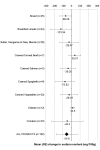Changes in the sodium content of New Zealand processed foods: 2003-2013
- PMID: 26024294
- PMCID: PMC4488772
- DOI: 10.3390/nu7064054
Changes in the sodium content of New Zealand processed foods: 2003-2013
Abstract
Decreasing population sodium intake has been identified as a "best buy" for reducing non-communicable disease. The aim of this study was to explore 10-year changes in the sodium content of New Zealand processed foods. Nutrient data for nine key food groups were collected in supermarkets in 2003 (n = 323) and 2013 (n = 885). Mean (SD) and median (min, max) sodium content were calculated by food group, year and label type (private/branded). Paired t-tests explored changes in sodium content for all products available for sale in both years (matched; n = 182). The mean (SD) sodium content of all foods was 436 (263) mg (100 g)(-1) in 2003 and 433 (304) mg (100 g)(-1) in 2013, with no significant difference in matched products over time (mean (SD) difference, -56 (122) mg (100 g)(-1), 12%; p = 0.22). The largest percentage reductions in sodium (for matched products) were observed for Breakfast Cereals (28%; -123 (125) mg (100 g)(-1)), Canned Spaghetti (15%; -76 (111) mg (100 g)(-1)) and Bread (14%; -68 (69) mg (100 g)(-1)). The reduction in sodium was greater for matched private vs. branded foods (-69 vs. -50 mg (100 g)(-1), both p < 0.001). There has been modest progress with sodium reduction in some New Zealand food categories over the past 10 years. A renewed focus across the whole food supply is needed if New Zealand is to meet its global commitment to reducing population sodium intake.
Keywords: New Zealand; food analysis; packaged food; processed food; salt; sodium.
Figures
Comment in
-
Comment on: Changes in the Sodium Content of New Zealand Processed Foods: 2003-2013 by D. Monro, C. Mhurchu, Y. Jiang, D. Gorton, H. Eyles. Nutrients 2015, 7(6), 4054-4067; doi:10.3390/nu7064054.Nutrients. 2015 Jul 17;7(7):5961-4. doi: 10.3390/nu7075261. Nutrients. 2015. PMID: 26193316 Free PMC article. No abstract available.
-
Response to a Letter to the Editor from Katherine Rich.Nutrients. 2015 Jul 20;7(7):5965-8. doi: 10.3390/nu7075264. Nutrients. 2015. PMID: 26205162 Free PMC article. No abstract available.
Similar articles
-
The Science of Salt: A global review on changes in sodium levels in foods.J Clin Hypertens (Greenwich). 2019 Aug;21(8):1043-1056. doi: 10.1111/jch.13628. Epub 2019 Jul 13. J Clin Hypertens (Greenwich). 2019. PMID: 31301120 Free PMC article. Review.
-
Changes in Average Sodium Content of Prepacked Foods in Slovenia during 2011-2015.Nutrients. 2017 Aug 29;9(9):952. doi: 10.3390/nu9090952. Nutrients. 2017. PMID: 28850061 Free PMC article.
-
A Comparison of the Sodium Content of Supermarket Private-Label and Branded Foods in Australia.Nutrients. 2015 Aug 21;7(8):7027-41. doi: 10.3390/nu7085321. Nutrients. 2015. PMID: 26308047 Free PMC article.
-
Achieving the WHO sodium target: estimation of reductions required in the sodium content of packaged foods and other sources of dietary sodium.Am J Clin Nutr. 2016 Aug;104(2):470-9. doi: 10.3945/ajcn.115.125146. Epub 2016 Jul 6. Am J Clin Nutr. 2016. PMID: 27385612
-
North American considerations, strategies, and practices in reducing the sodium content in processed foods.J Food Sci. 2024 Oct;89(10):6086-6097. doi: 10.1111/1750-3841.17361. Epub 2024 Sep 17. J Food Sci. 2024. PMID: 39289814 Review.
Cited by
-
Comment on: Changes in the Sodium Content of New Zealand Processed Foods: 2003-2013 by D. Monro, C. Mhurchu, Y. Jiang, D. Gorton, H. Eyles. Nutrients 2015, 7(6), 4054-4067; doi:10.3390/nu7064054.Nutrients. 2015 Jul 17;7(7):5961-4. doi: 10.3390/nu7075261. Nutrients. 2015. PMID: 26193316 Free PMC article. No abstract available.
-
The Science of Salt: A global review on changes in sodium levels in foods.J Clin Hypertens (Greenwich). 2019 Aug;21(8):1043-1056. doi: 10.1111/jch.13628. Epub 2019 Jul 13. J Clin Hypertens (Greenwich). 2019. PMID: 31301120 Free PMC article. Review.
-
Changes in Average Sodium Content of Prepacked Foods in Slovenia during 2011-2015.Nutrients. 2017 Aug 29;9(9):952. doi: 10.3390/nu9090952. Nutrients. 2017. PMID: 28850061 Free PMC article.
-
Comparison of Healthiness, Labelling, and Price between Private and Branded Label Packaged Foods in New Zealand (2015-2019).Nutrients. 2021 Aug 9;13(8):2731. doi: 10.3390/nu13082731. Nutrients. 2021. PMID: 34444891 Free PMC article.
-
Reformulation of Processed Yogurt and Breakfast Cereals over Time: A Scoping Review.Int J Environ Res Public Health. 2023 Feb 14;20(4):3322. doi: 10.3390/ijerph20043322. Int J Environ Res Public Health. 2023. PMID: 36834017 Free PMC article.
References
-
- Lim S.S., Vos T., Flaxman A.D., Danaei G., Shibuya K., Adair-Rohani H., AlMazroa M.A., Amann M., Anderson H.R., Andrews K.G., et al. A comparative risk assessment of burden of disease and injury attributable to 67 risk factors and risk factor clusters in 21 regions, 1990–2010: A systematic analysis for the Global Burden of Disease Study 2010. Lancet. 2012;380:2224–2260. doi: 10.1016/S0140-6736(12)61766-8. - DOI - PMC - PubMed
-
- World Health Organization Guideline: Sodium Intake for Adults and Children. [(accessed on 18 February 2013)]. Available online: http://www.who.int/nutrition/publications/guidelines/sodium_intake_print....
-
- Sadler K., Nicholson S., Steer T., Gill V., Bates B., Tipping S., Cox L., Lennox A., Prentice A. National Diet and Nutrition Survey—Assessment of Dietary Sodium in Adults (Aged 19 to 64 years) in England, 2011. Department of Health; London, United Kingdom: 2012.
-
- United States Department of Agriculture, Food Surveys Research Group Sodium intake of the US population. [(accessed on 22 May 2015)];What We Eat in America, NHANES 2007–2008. 2011 Available online: www.ars.usda.gov/ba/bhnrc/fsrg. - PubMed
-
- Slimani N., Deharveng G., Southgate D.A.T., Biessy C., Chajès V., van Bakel M.M.E., Boutron-Ruault M.C., McTaggart A., Grioni S., Verkaik-Kloosterman J., et al. Contribution of highly industrially processed foods to the nutrient intakes and patterns of middle-aged populations in the European Prospective Investigation into Cancer and Nutrition study. Eur. J. Clin. Nutr. 2009;63:S206–S225. doi: 10.1038/ejcn.2009.82. - DOI - PubMed
Publication types
MeSH terms
Substances
LinkOut - more resources
Full Text Sources
Other Literature Sources
Medical
Miscellaneous


